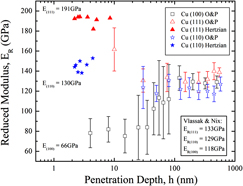Crossref Citations
This article has been cited by the following publications. This list is generated based on data provided by
Crossref.
Karmarkar, Aditya P.
Xu, Xiaopeng
Yeap, Kong-Boon
and
Zschech, Ehrenfried
2012.
Copper Anisotropy Effects in Three-Dimensional Integrated Circuits Using Through-Silicon Vias.
IEEE Transactions on Device and Materials Reliability,
Vol. 12,
Issue. 2,
p.
225.
Yeap, Kong-Boon
Roellig, Mike
Huebner, Rene
Gall, Martin
Sukharev, Valeriy
and
Zschech, Ehrenfried
2012.
A Critical Review on Multiscale Material Database Requirement for Accurate Three-Dimensional IC Simulation Input.
IEEE Transactions on Device and Materials Reliability,
Vol. 12,
Issue. 2,
p.
217.
Okoro, Chukwudi
Levine, Lyle E.
Xu, Ruqing
Tischler, Jonathan Z.
Liu, Wenjun
Kirillov, Oleg
Hummler, Klaus
and
Obeng, Yaw S.
2013.
X-ray micro-beam diffraction determination of full stress tensors in Cu TSVs.
p.
648.
Sander, Christoph
Gall, Martin
Yeap, Kong Boon
and
Zschech, Ehrenfried
2013.
Advanced 3D Packaging of Chips and Materials Integrity: Stress-Induced Effects and Mechanical Properties of New Ultra Low-k Dielectrics for On-Chip Interconnect Stacks.
Key Engineering Materials,
Vol. 592-593,
Issue. ,
p.
563.
Jung, Moongon
Pan, David Z.
and
Lim, Sung Kyu
2014.
Through-silicon-via material property variation impact on full-chip reliability and timing.
p.
105.
Shishido, Nobuyuki
Oura, Yuka
Sato, Hisashi
Kamiya, Shoji
Koiwa, Kozo
Omiya, Masaki
Nishida, Masahiro
Suzuki, Takashi
Nakamura, Tomoji
Nokuo, Takeshi
and
Suzuki, Toshiaki
2014.
Crystal orientation effect on local adhesion strength of the interface between a damascene copper line and the insulation layer.
Microelectronic Engineering,
Vol. 120,
Issue. ,
p.
71.
Wu, Zhiyong
Huang, Zhiheng
Ma, Yucheng
Xiong, Hua
and
Conway, Paul P.
2014.
Effects of the microstructure of copper through-silicon vias on their thermally induced linear elastic mechanical behavior.
Electronic Materials Letters,
Vol. 10,
Issue. 1,
p.
281.
Koiwa, Kozo
Shishido, Nobuyuki
Chen, Chuantong
Omiya, Masaki
Kamiya, Shoji
Sato, Hisashi
Nishida, Masahiro
Suzuki, Takashi
Nakamura, Tomoji
Suzuki, Toshiaki
and
Nokuo, Takeshi
2016.
Investigation of continuous deformation behavior around initial yield point of single crystal copper by using micro scale torsion test.
Scripta Materialia,
Vol. 111,
Issue. ,
p.
94.
Zschech, Ehrenfried
Gall, Martin
Clausner, Andre
Sander, Christoph
and
Sukharev, Valeriy
2016.
Novel approaches to determine thermomechanical materials data in advanced interconnect stacks.
p.
86.
Basavalingappa, Adarsh
Shen, Ming Y.
and
Lloyd, James R.
2016.
Effect of texture and elastic anisotropy of copper microstructure on reliability.
p.
57.
Basavalingappa, Adarsh
and
Lloyd, James R.
2017.
Effect of Microstructure and Anisotropy of Copper on Reliability in Nanoscale Interconnects.
IEEE Transactions on Device and Materials Reliability,
Vol. 17,
Issue. 1,
p.
69.
Karmarkar, Aditya P.
Xu, Xiaopeng
and
El-Sayed, Karim
2017.
Temperature and Process Dependent Material Characterization and Multiscale Stress Evolution Analysis for Performance and Reliability Management under Chip Package Interaction.
International Symposium on Microelectronics,
Vol. 2017,
Issue. 1,
p.
000013.
Basavalingappa, Adarsh
Shen, Ming Y.
and
Lloyd, James R.
2017.
Modeling the copper microstructure and elastic anisotropy and studying its impact on reliability in nanoscale interconnects.
Mechanics of Advanced Materials and Modern Processes,
Vol. 3,
Issue. 1,
Munawar Chaudhri, M.
2018.
Some concerns about the current interpretation and analyses of indentation unloading P – h curves highlighted with Young's modulus studies of single crystals of MgO (100).
Journal of Applied Physics,
Vol. 124,
Issue. 9,
p.
095107.
Zhao, Pengyue
and
Guo, Yongbo
2018.
Grain size effects on indentation-induced defect evolution and plastic deformation mechanism of ploycrystalline materials.
Computational Materials Science,
Vol. 155,
Issue. ,
p.
431.
Zhao, Pengyue
and
Guo, Yongbo
2019.
Effect of Initial Indentation Position on Plastic Deformation Behaviors of Polycrystalline Materials via Molecular Dynamics Simulation.
Nano,
Vol. 14,
Issue. 01,
p.
1950001.
Liang, S. B.
Ke, C. B.
Wei, C.
Zhou, M. B.
and
Zhang, X. P.
2019.
Study of the Influence of Elastic Anisotropy of Cu on Thermo-Mechanical Behavior and Cu Protrusion of Through Silicon Vias Using Combined Phase Field and Finite Element Methods.
IEEE Transactions on Device and Materials Reliability,
Vol. 19,
Issue. 2,
p.
322.
Chen, Xiaohu
Zhang, Pingze
Wei, Dongbo
Huang, Xiao
Adriana, Soveja
Michel, Chaussumier
Ding, Feng
and
Li, Fengkun
2019.
Structures and properties of Ti-5Al-5Mo-5V-1Cr-1Fe after Nb implantation.
Surface and Coatings Technology,
Vol. 358,
Issue. ,
p.
676.
Roa, Simón
and
Sirena, Martín
2021.
Thickness and microstructure influence on the nanocrystalline Cu thin films’ mechanical properties.
Journal of Materials Research,
Vol. 36,
Issue. 4,
p.
938.
Kim, Hangeul
Jeon, Hansol
Lee, Dong-Ju
and
Kim, Ju-Young
2021.
Surface residual stress in amorphous SiO2 insulating layer on Si substrate near a Cu through-silicon via (TSV) investigated by nanoindentation.
Materials Science in Semiconductor Processing,
Vol. 135,
Issue. ,
p.
106153.



